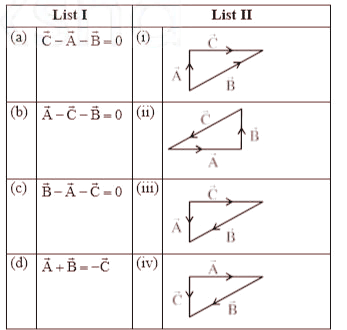Match List I with List II
List I ListII(Monomer unit) (Polymer)(a) Carprolactum (i) Natural ruber(b)2-Chloro-1-,3-butadience (ii) Buna-N(c) Isoperene (iii) Nylon 6(d) Acrylonitrile (iv) Neoprene
Chosse the correct answer from the options given below
(a)→(iv),(b)→(iii),(c)→(ii),(d)→(i)
(a)→(ii),(b)→(i),(c)→(iv),d→(iii)
(a)→(iii),(b)→(iv),(c)→(i),(d)→(ii)
(a)→(i),(b)→(ii),(c)→(iii),(d)→(iv)
The correct Answer is:C
To solve the problem of matching the monomers from List I with their corresponding polymers from List II, we will analyze each monomer and identify the polymer it forms.
Step 1: Identify the Monomer and its Corresponding Polymer
1. Carprolactam:
- Carprolactam is the monomer for Nylon 6.
- Match: (a) Carprolactam → (iii) Nylon 6
2. 2-Chloro-1,3-butadiene:
- This monomer is known as chloroprene, which is used to make Neoprene.
- Match: (b) 2-Chloro-1,3-butadiene → (iv) Neoprene
3. Isoprene:
- Isoprene is the monomer for Natural Rubber.
- Match: (c) Isoprene → (i) Natural Rubber
4. Acrylonitrile:
- Acrylonitrile is used along with butadiene to form Buna-N.
- Match: (d) Acrylonitrile → (ii) Buna-N
Summary of Matches:
- (a) Carprolactam → (iii) Nylon 6
- (b) 2-Chloro-1,3-butadiene → (iv) Neoprene
- (c) Isoprene → (i) Natural Rubber
- (d) Acrylonitrile → (ii) Buna-N
Final Answer:
- (a) → (iii)
- (b) → (iv)
- (c) → (i)
- (d) → (ii)
1. Carprolactam:
- Carprolactam is the monomer for Nylon 6.
- Match: (a) Carprolactam → (iii) Nylon 6
- This monomer is known as chloroprene, which is used to make Neoprene.
- Match: (b) 2-Chloro-1,3-butadiene → (iv) Neoprene
- Isoprene is the monomer for Natural Rubber.
- Match: (c) Isoprene → (i) Natural Rubber
- Acrylonitrile is used along with butadiene to form Buna-N.
- Match: (d) Acrylonitrile → (ii) Buna-N
- (a) Carprolactam → (iii) Nylon 6
- (b) 2-Chloro-1,3-butadiene → (iv) Neoprene
- (c) Isoprene → (i) Natural Rubber
- (d) Acrylonitrile → (ii) Buna-N
- (a) → (iii)
- (b) → (iv)
- (c) → (i)
- (d) → (ii)
Topper's Solved these Questions
- BOOK - JEE MAINS PREVIOUS YEARCHAPTER - JEE MAIN 2021EXERCISE - SECTION-B50videos
JEE MAIN 2021
- BOOK - JEE MAINS PREVIOUS YEARCHAPTER - JEE MAIN 2021EXERCISE - CHEMISTRY (SECTION-A)20videos
JEE MAIN 2021
- BOOK - JEE MAINS PREVIOUS YEARCHAPTER - JEE MAIN 2021EXERCISE - Chemistry (Section B)10videos
JEE MAIN 2021
- BOOK - JEE MAINS PREVIOUS YEARCHAPTER - JEE MAINEXERCISE - CHEMISTRY150videos
JEE MAIN
- BOOK - JEE MAINS PREVIOUS YEARCHAPTER - JEE MAIN 2022EXERCISE - Question561videos
JEE MAIN 2022
Similar Questions
Knowledge Check
- Question 1 - Select One
Match List-I with List-II.
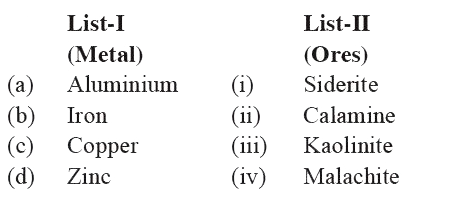
Choose the correct answer from the options given below :A(a)-(iv), (b)-(iii), (c)-(ii), (d)-(i)B(a)-(ii), (b)-(iv), (c)-(i), (d)-(iii)C(a)-(i), (b)-(ii), (c)-(iii), (d)-(iv)D(a)-(iii), (b)-(i), (c)-(iv), (d)-(ii) - Question 2 - Select One
Match List I with List II.
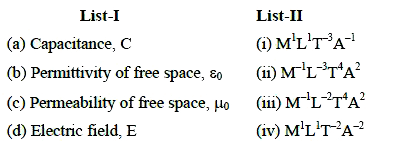
Choose the correct answer from the options given belowA(a) → (iii), (b) → (ii), (c ) → (iv), (d) → (i)B(a) → (iii), (b) → (iv), (c ) → (ii), (d) → (i)C(a) → (iv), (b) → (ii), (c ) → (iii), (d) → (i)D(a) → (iv), (b) → (iii), (c ) → (ii), (d) → (i)
Match List I with List II.
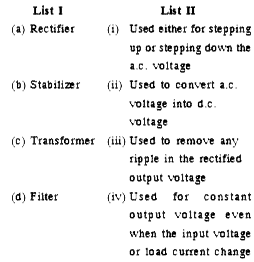
Choose the correct answer from the options given below :View SolutionMatch List-I with List-II
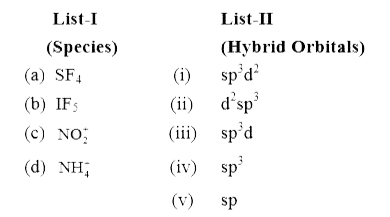
Choose the correct answer from the options given below:View SolutionMatch List-I with List-II
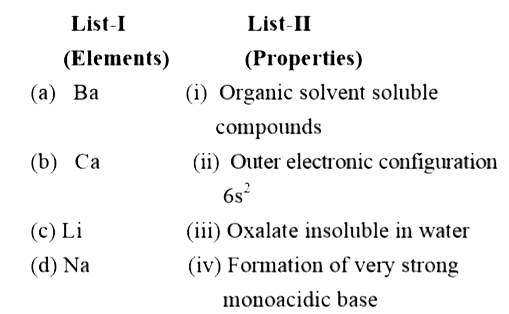
Choose the correct answer from the options given below:View SolutionMatch List-I with List-II
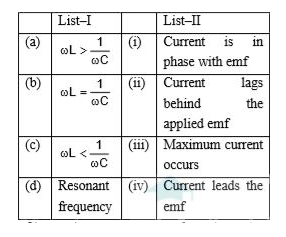
Choose the correct answer from the options given belowView SolutionMatch List-I with List-II
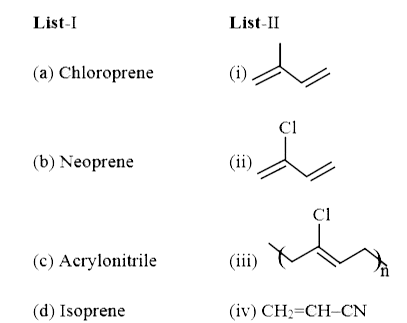
Choose the correct answer from the options given below:View SolutionMatch List-I with List-II:

Choose the correct answer from the options given below:View Solution


